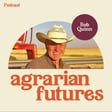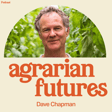
Financing Native Food Sovereignty with Skya Ducheneaux
On this show, we’ve talked a lot about how traditional banking and financial systems make it tough for new farmers or those without direct land ownership to get a fair shot. But those challenges run even deeper for agricultural producers in Indian Country.
Enter Skya Ducheneaux, who’s tackling these barriers head-on as the leader of Akiptan—the first Native CDFI dedicated to serving agricultural producers all across Indian Country. Skya brings fresh eyes to lending, challenging old-school banking practices that just don’t work for farmers without big land holdings or a long financial track record. Instead, Akiptan focuses on sweat equity, work ethic, hands-on support, and long-term solutions - and yield tremendous outcomes as a result.
In this episode, Skya shares:
- Her journey from growing up on a cattle ranch to leading a groundbreaking financial institution.
- Why extractive capital leads to extractive practices—and how patient, thoughtful capital can support regenerative agriculture.
- The unique ways Akiptan removes barriers and empowers Native ag producers.
- Remarkable success stories from the communities Akiptan serves.
- Why Native CDFIs have an opportunity to step up investment in agriculture.
- And how outside investors can better align with the long-term needs of Native farmers.
- And much more…
More about Skya and Akiptan:
Skya Ducheneaux is the Executive Director of Akiptan and is an enrolled member of the Cheyenne River Sioux Tribe. She spent her first 18 years of life on a cattle ranch on the CRST Reservation in South Dakota. She then pursued a Bachelors and Masters Degree in Business Administration while working at a county FSA office and buffalo meat processing plant. After returning home to work for the Intertribal Agriculture Council, she was tasked with creating the first Native CDFI dedicated to serving Native Agriculture producers all across Indian Country. Akiptan began lending in January of 2019 and has grown rapidly over the years.
In addition to Akiptan, Skya has served on many advisory committees and is currently the Board Chair of the Mountain Plains CDC. In her role as Executive Director, she is a part of several CDFI coalitions, advocates locally and federally and presents at conferences to share the mission of Akiptan.
Agrarian Futures is produced by Alexandre Miller, who also wrote our theme song. This episode was edited by Drew O’Doherty.



















